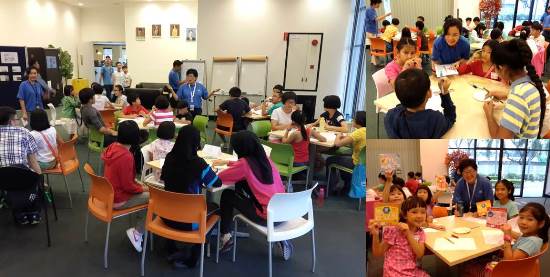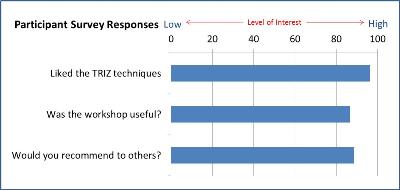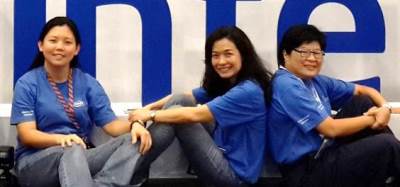As the old saying goes - curiosity killed the cat. While it may have affected many cats, it is the basis of education. The best approach to learning remains to be to trigger the curious minds of the children and allow them the opportunity to explore the subject matter.
Equipped with the learning from the School for Creative Thinkers workshop that was organized by MyTRIZ in November 2013, three participants were so motivated that they immediately took the opportunity to share their newly gained knowledge with their colleagues’ children.

At the Intel Malaysia Design Center - Bring your Kids to Work Day on 30 December 2013, Theresa Loh, Ong Boon Yean and Aileen Kee organized five workshops to impart the Open Problem Solving techniques to 125 children. The children and their parents gave a double thumbs-up on what was shared.
Following the standard business practice of multinationals to obtain customer feedback, the facilitator team collected and analyzed the feedback from the kids aged from 6-17 years old. The survey results showed strong correlation to the positive verbal feedback received.

“Both my kids attended the session and liked it very much – thanks to the team for conducting the workshop”, said one of their colleagues.
“My girl is 10, she finds the activities interesting and different from the normal activities”, chimed another departmental peer.

Upon receiving the participants’ positive feedback and encouraging words, it made the sacrifices by the facilitators even more worthwhile as they had to rush back from international business meetings and cancel their year-end annual holidays.
MyTRIZ caught up with the three facilitators to learn about their motivation and willingness to reprioritize their schedules to volunteer and give back to the community. MyTRIZ would like to share the insights from Ms. Theresa Loh, Ms. Ong Boon Yean and Ms. Aileen Kee on their experience.

What motivated the three of you to conduct the Be Creative-Open Problems workshop during the Intel Malaysia Design Center Bring the Kids to Work Day?
Theresa: After attending the TRIZ Level 1 and MyTRIZ Workshop 2013 School for Creative Thinkers, I tested some techniques with my own child. I was surprised by my 4 year old son's replies and discovered that children learn better by asking questions. I was impressed with his creative answers. The best part is when he found his own answers! Intrigued by the discovery, I wanted to share the techniques with more parents.
Boon Yean: It was an eye-opening experience for me when I learnt the art of asking questions from Mr. Anatoly Guin and Dr. Mark Barkan during the School for Creative Thinkers Workshop 2013. I felt that I would have benefited more if I have known the technique much earlier. To my surprise, Theresa, Aileen and several workshop participants shared the same thoughts. It was a great way to encourage creativity and innovation. While at the workshop, we started to explore ways to take this to more children and parents.
Aileen: Post the 3-day workshop, I was interested to use the new found techniques with a broader audience. I wanted to take the techniques and break them down for students and teachers. The baseline plan was to catch the first term holidays in 2014 but the opportunity presented itself with the Intel Malaysia Design Center Bring the Kids to Work Day. With the help and drive of Boon Yean and Theresa, we made it happen.

Why did you sacrifice your personal holidays or rush back from international business meetings to run the program?
Theresa: When I received the newsletter about the Bring Your Kids To Work Day, an immediate thought came to me. This would be an excellent event to include the Be Creative-Open Problems workshop. I forwarded the newsletter to Boon Yean and she too was thinking about the same opportunity. Without any hesitation, I approached the organizer and offered the program. The organizer in fact was extremely pleased with the offer and included the program. It was not any sacrifice from me as I was glad to be given the opportunity. I also had the other two wonderful ladies to work with.
Boon Yean: I was away on international trip and figured that I could change my flights to return in time. We had a very tight timeline and started the coordination meeting via the phone conference in the midst of juggling between business meetings and airports. Nonetheless the exceptional signed-up responses were so encouraging – we went from one session for 25 children to five sessions for 125 children. It does take a lot of effort to make things happen, and I know I am doing it with a very clear goal to enable more children and parents to learn about the Open Problem Solving techniques.
Aileen: I have always been passionate about developing the next generation. I strongly felt that the contents from the workshop would greatly benefit the kids. This is one way of giving back and also making a difference. I have spoken to several friends and they too were keen to bring the program to their schools – either to teach the teachers or reaching out directly to kids. Because Theresa, Boon Yean and I shared similar goal, it drove us to get the program organized.

How do you see the role of facilitator in the learning process?
Theresa: There were lots of brainstorming and preparation work to train the kids who were of different age groups. The facilitator plays an important part of the learning process. They must get the ball rolling. It was not easy to encourage some of the kids who were not so proactive to participate. You will need to guide the kids and make the learning fun. You must get feedback from the participants.
Boon Yean: Indeed I was happy to conduct the workshops even though recently trained. I am far from being a subject matter expert but conducting the 5 sessions has given me better appreciation of the techniques. I am still very excited post the learning workshop and teaching sessions. The question is how to scale out to more children.
Aileen: It is important to have a lead facilitator running the session and also facilitators assigned to each group of the participants. Ideal ratio may be one facilitator to five participants but this can be reduced if the kids are older. It is important to use instructional language that the kids can relate to and examples that are familiar to them.
MyTRIZ would like to take this opportunity to thank the three facilitators for taking the time and effort to share their learning.

Curiosity does not usually kill cats. The cats have a knack to land on their feet after a fall and dodge death by a whisker. They are quite a fearless explorer. These creatures with nine lives can afford to take risks. Accorded with such gifts, we hope to encourage more trained facilitators to mirror the efforts, develop the young creative minds and allow them to take risks.












